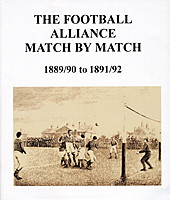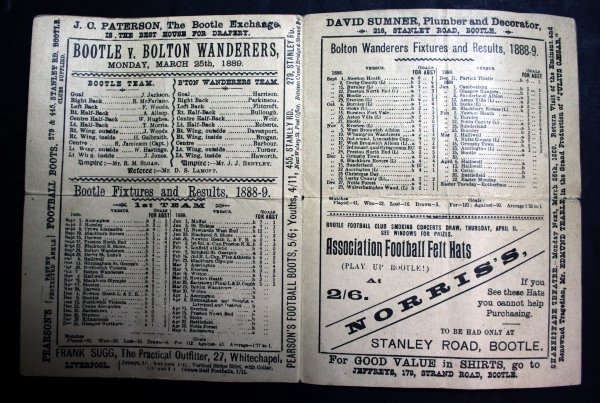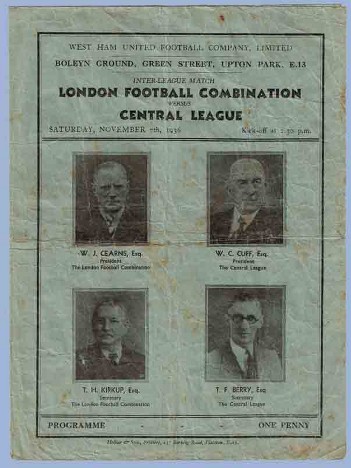The Football Alliance: Teams Who Didn’t Make the League
The Football Alliance was the most successful of the short-lived rivals to the Football League. The League’s founder, William McGregor, had ensured it would be an exclusive institution from its formation in 1888. McGregor issued his famous letter to invite only a select group of clubs to join the proposed new competition.

The number of Football League clubs was initially fixed at twelve to limit the number of fixtures to a realistic amount. While McGregor envisaged that revenue would be shared between the League’s members, he and his colleagues also had an eye on maximising that revenue. No more than one club from a given city was to be admitted, and each came from a centre of population exceeding 60,000. The restriction excluded some worthy candidates; naturally, McGregor’s own club, Aston Villa, had the primary claim ahead of neighbours Birmingham [Mitchell] St George’s. Everton were the chosen Liverpool side, much to Bootle’s annoyance, while Notts County edged out Nottingham Forest.
Halliwell missed out in Bolton, while 1883 FA Cup winners Blackburn Olympic found themselves overlooked as rivals Rovers – who won the Cup in the following three years, 1884 to 1886 – had emerged as the town’s strongest club. Surprisingly neither Manchester nor Sheffield initially had League representation, despite the latter city’s long football history.

A group representing those aggrieved clubs who didn’t make the cut for McGregor’s League met shortly after to discuss forming a rival competition. Initiated by Crewe Alexandra secretary J. G. Hall, the Combination was announced at the Royal Hotel in Crewe, to begin later in 1888. Its president was Harry Mitchell of the Mitchell (Birmingham) St. George’s club. Comprising twenty teams, there were to be sixteen games per club in the ‘second league’, to be arranged between themselves. The Football League quickly proved itself a success, though the question of determining how points were to be awarded was not resolved until three months into the first season. Despite such early teething problems, the League’s administration met the new challenges admirably, benefitting from the structure of home and away fixtures. By contrast, the Combination suffered from a lack of central organisation, with poor planning and unfulfilled fixtures. The competition failed to even complete its first season, being disbanded in April 1889 without a winner.

Heeding this lesson, several of the Combination’s clubs regrouped and launched another league the following year after a meeting at the Douglas Hotel, Manchester. Modelled on the League with a more manageable twelve clubs, the Football Alliance ran for three seasons. Like the League itself, clubs were drawn from the north and midlands, and its Champions from 1890-92 were The Wednesday, Stoke (the first team to leave the Football League) and Nottingham Forest. President of The Wednesday, John Holmes, also served in the same role for the Football Alliance.
Both Ardwick, later Manchester City, and Newton Heath, not to become Manchester United until 1902, were members of the Alliance. Darwen, the east Lancashire club which had engaged football’s first known professional, Fergus Suter, were also among the founders. The east Lancashire club were to benefit from the Football League’s first expansion in 1891. The other club to gain admission when the First Division went up to fourteen teams was Sunderland, elected at Stoke’s expense. By 1895 the ‘team of all talents’ had won three League titles, and their local rivals Sunderland Albion who had competed in the Alliance, were out of existence.

The strength of the rival competition was illustrated when The Wednesday reached the 1890 FA Cup Final, losing to Blackburn Rovers – six years later, as a League club, they lifted the trophy themselves. An inter-league representative fixture was played at Sheffield’s Olive Grove, home of The Wednesday, in April 1891 – the Alliance and the League again proved evenly-matched in a 1-1 draw. The leagues also met off the pitch in December 1891 to discuss the sensitive issue of ‘poaching’ players, limiting signing-on fees to £10 to discourage illegal approaches. Players from the ‘junior league’ including Forest’s Tinsley Lindley also represented England during the period of the Alliance’s existence.
The Alliance’s status was confirmed when the Football League expanded to two divisions in 1892. According to League historian Dave Twydell, “At a Football League meeting in Birmingham on the 23rd of March [1892], it was resolved that the Alliance would form the new Second Division for the next season.” Three sides – The Wednesday, Nottingham Forest and Newton Heath – were elected straight into the First Division. The remaining teams from the Alliance made up the bulk of the twelve clubs in the newly-formed Second Division. Birmingham St George’s, once rivals to Aston Villa, were the only Alliance side not to enter the League as they disbanded. Another Birmingham club from the Alliance, Small Heath, became the first winners of the Second Division in 1892/93 (only to miss out on promotion after losing to Newton Heath in the inaugural Football League play-offs or ‘test matches’).

There were at least two further incarnations of the Combination, in the North-West and London. With the success of the Football League, clubs were able to field reserve teams; the Combination which ran from 1890 until 1911 in the North-West was dominated by Everton’s reserves, and included future league sides such as Burton Swifts, Chester, Tranmere Rovers and Wrexham. The London Combination was the name used for a league of the major London clubs founded in 1915 to play wartime fixtures. Once these sides re-joined the Football League in 1919, the league became a reserve-team competition. Renamed as the Football Combination in 1939 and relaunched after World War II, when several ‘provincial’ southern sides were added, it remained in existence until 2012.
The equivalent for northern and midlands clubs who failed to gain Football League status was the Central League, founded in 1911. It too was supplemented by the reserve teams of league clubs until 1921, when all the first teams became part of the newly-formed Third Division North. Its first champions were Lincoln City, recently voted out of the league (and soon to return), but afterwards all its winners were second teams. The Football Combination and Central League were the mainstays of English reserve-team football before the Premier League and the academy model.

Members of the Combination (1888): Birmingham St Georges, Blackburn Olympic, Bootle, Burslem Port Vale, Crewe Alexandra, Darwen, Derby Midland, Derby Junction, Gainsborough Trinity, Grimsby Town, Halliwell, Leek Town, Lincoln City, Long Eaton Rangers, Newton Heath, Northwich Victoria, Notts Rangers, Small Heath, South Shore, and Walsall Town Swifts.

Members of the Football Alliance (1889-92 unless stated): Ardwick (1891-92), Birmingham St Georges, Bootle, Burton Swifts (1891-92), Crewe Alexandra, Darwen (1889-91), Grimsby Town, Lincoln City (1891-92), Long Eaton Rangers (1889-90), Newton Heath, Nottingham Forest, Small Heath, Stoke (1890-91), Sunderland Albion (1889-91), The Wednesday, and Walsall Town Swifts.


The Football Alliance & The Football Combination – list of officials/ secretaries & fixtures 1890/91 (Athletic News Annual, National Football Museum)
Nice article.
Royal Arsenal considered applying for membership of the Football Alliance after they turned professional in 1891. However, they missed the opportunity for the 1891-92 season and then it didn’t exist for the 1892-93 season. They eventually joined the Football League in 1893 (as Woolwich Arsenal).
The London Combination was renamed the Football Combination in 1939 but was abandoned after most teams had played only one or two games.
Here’s the programme for Arsenal v Leicester City played in 26 August 1939.
http://thearsenalcollection.org.uk/arsenal-v-leicester-city-football-combination-saturday-august-26th-1969/
It started again in 1944-45 under the name of the London Combination but without a full complement of teams. Arsenal and Tottenham didn’t compete as they were groundsharing and neither had a reserve team as they had nowhere to play.
Thank you for reading and commenting Andy, it’s much appreciated. The geographical spread of the early League is an interesting one, and probably an article on its own…
I found different dates for the renaming of the Combination, so thanks for clarifying that. I’ve dipped into the Arsenal Collection before for research, it’s a great resource – whoever you support!
Another great article. Thank you.
Poor Bootle – one of only two clubs to play just one season in the Football League (assuming Salford City play another one) 🙂
Robert, thank you for reading and commenting. Bootle were just unlucky to be in the wrong city – but at least they had their season in the League!